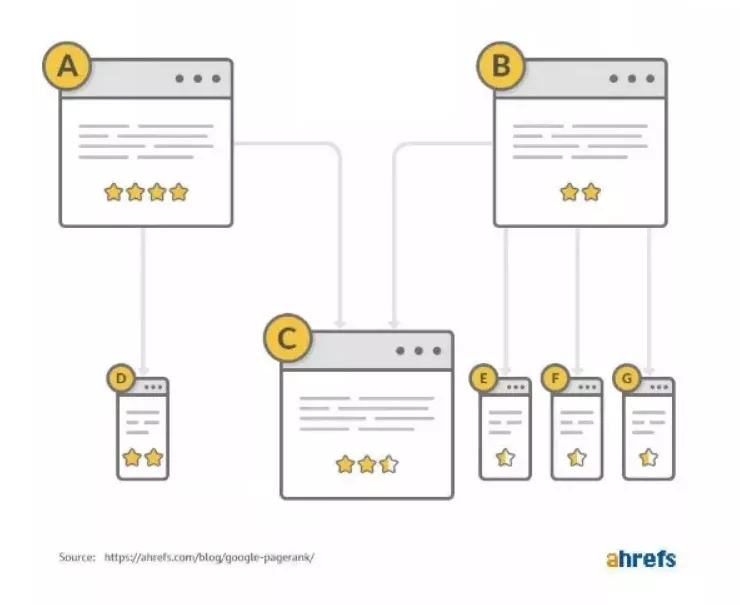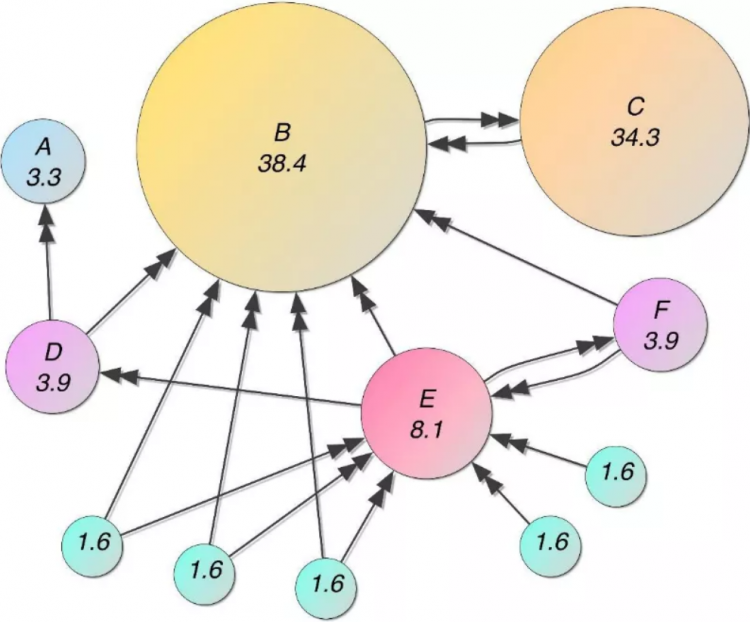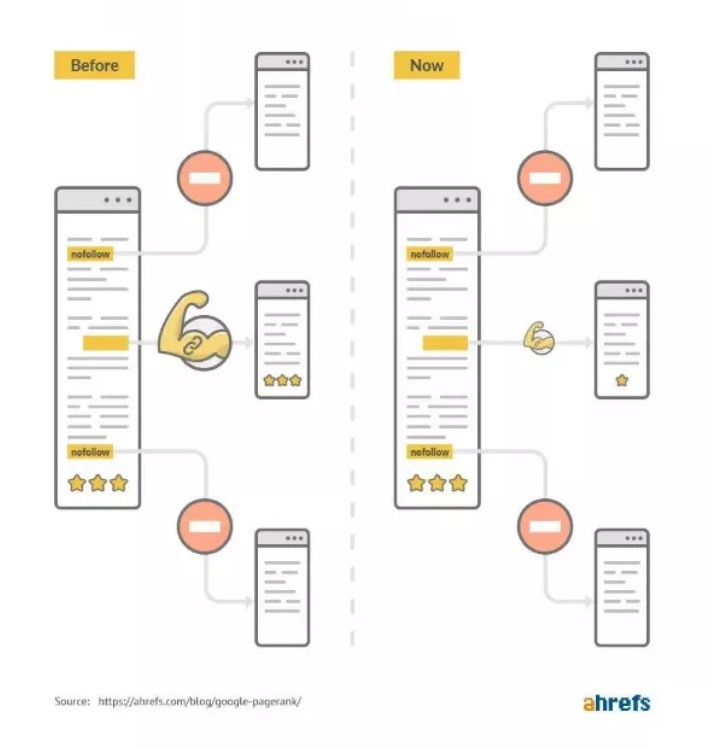Recently, many have forgotten about the PageRank indicator, which the Google search engine used a few years ago. At one point, it was possible to see the PageRank value for a particular website, but it is no longer displayed by the search engine.
Even though it is no longer visible, PageRank has not lost its importance. It still plays a crucial role in promoting electronic resources, making it worth examining. Let’s take a closer look at PageRank.
Why Do You Need PageRank?
First, let's look at the definition of PageRank.
PageRank is a link ranking algorithm that shows the importance of a link for search engines in particular. This importance is represented by a numerical value from 0 to 10. The points are calculated on a logarithmic scale. So, while the difference between 0 and 1 is small, the difference between 8 and 9 is huge.
The PageRank of a page depends on the number of links leading to it as well as their quality. The more often other websites refer to a specific source, the more authoritative it is considered. Therefore, its PageRank will be higher.
How PageRank works (simplified diagram)
PageRank is divided equally between the total number of links on a page
Until 2014, users could easily check the PageRank for a given webpage in the Google Toolbar. Then it stopped being updated, so users started to lose interest in the feature. Since 2016, the system has not displayed the parameter at all.
Many website owners assumed that PageRank, a webpage authority indicator, had simply ceased to exist. However, this misconception has been refuted by the representatives of Google, who reported that they concealed the PageRank values in order to prevent the scores from being manipulated.
As before, PageRank continues to play an important role in assessing the quality and importance of pages. It is necessarily taken into account by the search engine when determining the position of a resource in the search results.
Given the importance of the indicator, website owners often wonder about finding out the PageRank of their website and if it can be determined at all. With the actual score, it is possible for site owners to evaluate the attractiveness of their site for the search engine and take effective measures to increase it.
How is PageRank Determined?
Now that you know what Google PageRank is, the next step is to understand how it is determined. Admittedly, there isn't much information on this topic, but it is still possible to use certain principles and formulas to get an idea of the PageRank score.
PageRank is derived from the number of internal and external links leading to a page, as well as the degree of their importance. It is determined for each page separately, not for the whole site. When calculating the score, the following factors are taken into account:
- the number and quality of external links
- the number of outbound links
- PageRank (PR) of each linking page
The calculation formula is as follows:
PR(A) = (1-d) + d (PR(T1) / C(T1) + ... + PR(Tn) / C(Tn)).
Let's consider the variables and their definitions:
- PR(A) is the required equity of the page’s PageRank.
- d is the attenuation factor and is often set at 0.85.
- PR(T1) is the PageRank equity of the page linking to page A.
- C(T1) is the number of links from this page.
- PR(Tn) / C(Tn) are calculations for each page pointing to A.
As mentioned above, the maximum possible PR is 10, while the minimum is 0.
The calculations may be time-consuming, but it is certainly possible to obtain a PageRank score for a webpage and evaluate the page’s credibility from the viewpoint of the search engine. The only thing that cannot be reliably confirmed is whether there have been any changes in this area recently and how accurate the scoring method is for the PR parameter.
How to Increase PageRank
There are many different ways of increasing the PageRank of a webpage.
Be strategic with internal links
Let's start with internal links, as these affect the PR indicator. Internal links are available to the site owner, making them easy to work with. With internal links, it is necessary to evaluate the degree of interlinking.
For instance, if all the pages of the resource link to each other, the PR is distributed evenly, but the links lose some of their equity due to their number. Such a structure should not be used for large portals with a large number of pages.
With regards to sites that have a hierarchical structure, the greatest equity is given to the main page. If there are a lot of references from it, then the authority of the pages will decrease. Therefore, it is necessary to control the level of nesting. The best solution is for each landing page to open no more than three clicks away from the main page.
Make the most of external links
As for external links, you need to ensure they are located on different domains. If they are placed on one site or on a single page, the PageRank indicator will not be affected, and the work will have been done in vain.
It is necessary to take into account the number of clicks on the backlink. The more interesting and useful the page's content is, the better. More attractive content will make it possible to increase the equity of the backlink.
Next, do not forget about the location of the external link in the reference text. The closer the link is to the beginning of the material, the more effective it is. Even if the user does not read the entire article, they will see the link if it is placed near the top and are likelier to click on it. The reference text leading to the external link should be clear and engaging and explain what the person will find on the proposed page.
It is important to know that links with the "nofollow" tag are not taken into account by the search engine. Therefore, the comments on other people's blogs will not affect the PageRank of your site.
Why PageRank management doesn't work anymore
Link weight is now divided between all links on the page regardless of the nofollow tag
When selecting sites and pages for placing backlinks, you should take into account the following criteria:
- Compliance with the subject. Prioritize resources that are of interest to your target audience. Links posted on such sites will increase the PageRank and attract target users.
- Page authority. Even if the sites are not considered authoritative, but materials from certain pages are actively cited, links from such resources will be very valuable.
- The number of outbound links. If there are a lot of outbound links on one page, then the importance will fall accordingly.
- Attendance. The higher it is, the more profitable it is to work with such a platform. Links will carry a lot of equity.
These are the main points to remember when planning to increase your website’s PageRank.
How to Check the PageRank of a Website Page
Since Google no longer publicizes the PageRank indicator, website owners often wonder how to make the most of it. In fact, getting the actual figure and knowing the equity of the page is still a real conundrum, even today.
Thankfully, there are certain applications to help with this, for example, Free Link Checker and Netpeak Spider. There are a lot of such programs, and you need to choose the one that will be the most convenient, informative, and accurate for your needs.
Above, we have given an example of PageRank calculation. But please note that Google, most likely, systematically changes the specific variables influencing the indicator and adds new criteria. Consequently, the scores obtained on specialized sites are not 100% accurate. But in general, PageRank does help site owners evaluate the pages and understand whether additional work is needed to promote the resource.
Also, PageRank calculations are worth performing because they often allow you to determine the dangling node. These are pages that do not have any outbound links. These pages do not transfer the equity but lose it, thus breaking the even distribution of link equity on the website.
Read more in our blog:
- What Is Link Building, and How to Get Backlinks Properly
- How and Where to Post Free Backlinks to Your Website
- Outreach Link Building – Step-by-step Guide
- SEO Benefits of Nofollow Links That Prove Their Significant Value
Key Takeaways
- PageRank is an important indicator that allows you to evaluate the importance and authoritativeness of a webpage for search engines. It makes it possible to understand whether the site needs improvement and allows site owners to correct existing shortcomings.
- PageRank is not displayed in the public domain, and the Google Toolbar is no longer available. However, the indicator itself continues to be significant and is taken into account by the search engine when evaluating a particular site. That is why it makes sense to calculate and increase the PageRank of a webpage.
Related Articles
How to Set Up Consent Mode in GA4 on Your Website with Google Tag Manager
Let's explore how to properly integrate consent mode in GA4, configure it for effective data collection, and at the same time comply with GDPR and other legal regulations
Display Advertising Effectiveness Analysis: A Comprehensive Approach to Measuring Its Impact
In this article, I will explain why you shouldn’t underestimate display advertising and how to analyze its impact using Google Analytics 4
Generative Engine Optimization: What Businesses Get From Ranking in SearchGPT
Companies that master SearchGPT SEO and generative engine optimization will capture high-intent traffic from users seeking direct, authoritative answers






